 Facing Violence: Preparing for the Unexpected by Rory Miller
Facing Violence: Preparing for the Unexpected by Rory Miller
My rating: 5 of 5 stars
If you teach martial arts or self defense, especially if you teach young men, you must read Facing Violence: Preparing for the Unexpected. It covers the dynamics of violence, both violence perpetrated by social predators and violence that stems from social posturing and dominance behavior (the “monkey dance”).
As an author, I have a lot of respect for Sgt. Miller’s writing abilities. The book is nicely structured and tightly written. The style matches the content perfectly–clear, straightforward, no-nonsense. As a martial artist who hasn’t been in the trenches, I am grateful for his insights and examples. Sgt. Miller, as a protector of society, has seen it all. Because he has seen it all and has thoroughly processed it for himself, he is able to describe it to us members of society who sincerely hope we never see any of it. I have read a several books of its kind, and this one is hands-down the best. He has written an emergency book–what do do when faced with real-world violence–that will undoubtedly save lives.
As an aside, I have a request for his next book: facing domestic violence. This book addresses predator violence and dominance behavior violence. It’s outstanding in the way it addresses the kind of violence men (and some women) face. Next, I’d like to see Miller’s take on male-female violence, particularly between intimates.
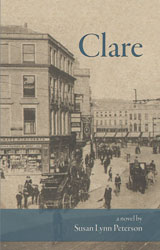
Clare is now available in most of the major ebook formats. I’ve set the free sample size to 20% and the price at a special introductory rate of $2.99. Check it out on Smashwords. If you’re reading on a Kindle, it’s still available on amazon.com, also for $2.99.
I’ve been experimenting with a recipe for cooking dried beans in the solar oven. I’ve found one that I think makes some the best beans I’ve ever tasted. I wrote it up and put it on eHow, so it will reach a larger readership than this blog. If you’re curious, you can find it here. The trick is overnight soaking and then allowing the rising sun to bring up the heat gradually. Not tracking the sun allows the beans to cool slowly in their juices making for a nice tender (but not mushy) bean.
The quality of solar-cooked beans and sweet potatoes alone are are reason enough to get a solar oven. I have a SOS Sport. If you’re thinking of getting one, email me, and I’ll tell you about my experiences with it.
My mother, who is in her early 80s, recently went in for a doctor appointment. The physician, a young, personable, well-educated physician, commented that at 80 my mother really didn’t need to be watching her diet any more. When I heard about it, I thought, “there is the central problem with Western nutrition theory wrapped up in one statement.”
 According to your typical M.D., food contains nutrients. Some nutrients cause health problems. Some solve health problems (health problems like early death, hence the statement that at 80, you don’t have to watch your diet). Don’t eat eggs because they contain cholesterol and cholesterol is bad for you. Do eat orange juice because orange juice contains vitamin C, and vitamin C is good for you, especially if you are fighting a cold. So what’s my problem? Isn’t cholesterol bad for you? Isn’t vitamin C good for you?
According to your typical M.D., food contains nutrients. Some nutrients cause health problems. Some solve health problems (health problems like early death, hence the statement that at 80, you don’t have to watch your diet). Don’t eat eggs because they contain cholesterol and cholesterol is bad for you. Do eat orange juice because orange juice contains vitamin C, and vitamin C is good for you, especially if you are fighting a cold. So what’s my problem? Isn’t cholesterol bad for you? Isn’t vitamin C good for you?
Frankly, I don’t know. I’m not a scientist. I’m going to give the researchers who study such things credit for knowing their field and for doing due diligence in their experiments. I’m going to assume that vitamin C is good for you. My point, however, is that though we drink orange juice for vitamin C, orange juice isn’t vitamin C. Orange juice contains vitamin C. It also contains carbohydrates, water, other vitamins, minerals, acids and probably other nutrients we don’t even have a name for yet. Beyond what’s in it are its properties. It’s sweet. It’s sour. It’s wet. Traditional Chinese Medicine (TCM) would say that it’s “cool.” Then there’s the issue of what it does. Western medicine would say that the body reacts to the acid in the orange juice in a particular way. TCM would say that it rectifies qi and moistens the lungs. In other words, orange juice is more than just vitamin C, and it interacts with your body in a ways that pure vitamin C doesn’t.
So what?
Well, let’s say you’re coming down with a cold. You know that vitamin C is good for the immune system. So you swing by the grocery store on the way home from work, and you stockpile orange juice. You start swigging it at the rate of a couple of quarts a day, and before long the cold blossoms and then settles into your chest. From a TCM standpoint, none of this is a surprise. The sweetness of the orange juice is dampening, the sourness constrains, and the coolness, well, it makes things cool. So what you have in orange juice is a recipe for gunk and congestion that you can’t cough loose. The vitamin C, however, might be good for your immune system as you once again get stuck in a coughing fit that you fear might turn a lung inside out.
In our attempt to pinpoint the nutrients of food, we’ve lost the common sense that tells us how our bodies react to foods. We don’t drink the orange juice and ask ourselves if we feel better. We drink it because someone with a microscope and a graduate degree has told us it contains something good for us. We’ve forgotten that we are the experts on how our body feels from the inside. Is orange juice good for a cold? Try it. Then try a nice oolong or black tea instead. Listen. Really listen to what your body has to say.
I’m not saying to ignore what Western medicine has to say about foods. Use their insights as a jumping off point. Test them. Western researchers are concerned about demographics and long-term survival rates. They want a discrete variable, a vitamin or mineral, they can test in a lab. You want to stop feeling like crap all the time. The two are very different perspectives on food.
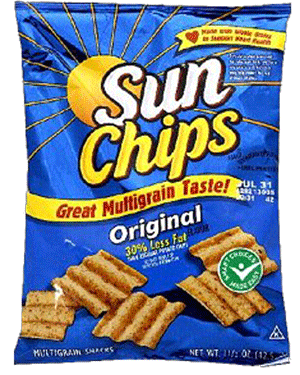 And while I’m on the subject, examine very closely any food whose label brags about something that’s supposedly good for you– fiber, vitamin D, probiotics, less fat, whatever. You could argue that someone stopping by your house to give you a hundred buck is a good thing. But someone driving the hundred buck through your front window and into your living room in a tank, well, that’s maybe not as good. What do you have to eat to get the much-vaunted fiber? How does it make you feel?
And while I’m on the subject, examine very closely any food whose label brags about something that’s supposedly good for you– fiber, vitamin D, probiotics, less fat, whatever. You could argue that someone stopping by your house to give you a hundred buck is a good thing. But someone driving the hundred buck through your front window and into your living room in a tank, well, that’s maybe not as good. What do you have to eat to get the much-vaunted fiber? How does it make you feel?
Beware a health food restaurant where everyone gets up from the table coughing and hacking up phlegm. (Listen to your favorite restaurant sometime. I guarantee you an eye-opening experience.) Beware the enriched bread that makes you feel logy and stuffy. Beware the fortified cereal that picks up blood sugar and then drops it like a Magic Mountain roller coaster.
Bottom line? Spinach never brags. Marketers brag.
Learning to listen to your body, and how your food choices affect it, is a much-neglected way of life in modern America. You’re not going to find many people practicing it. You’re not going to find many modern professionals who can help you develop the skills. But it really is central to navigating the mine field of food choices, food research, and food marketing pressure we experience every day.
If you want to go beyond following rules handed to you from above to develop your own inner wisdom about how your body lives with the food you feed it, you will be walking a road less traveled. Your best company along the way could be a TCM practitioner. I’d suggest Bob Flaw’s The Tao of Healthy Eating: Dietary Wisdom According to Traditional Chinese Medicine as a good place to start. In Tucson, David Price does dietary counseling from a TCM perspective. A TCM take on food is essentially the accumulation of thousands of years of people listening to their bodies. It’s as good a place as I’ve found so far to begin to learn to listen to my own body.
So do you need to be concerned about what you eat at 80 (or at 50, or 20, for that matter)? Only if you want to live in harmony with your food. Only if you want to live aware of your body. Only if you want to live deliberately as a whole person for all the days that are allotted you.
Thanks to timlewisnm on Flicker for the orange picture.
Hunger is simple enough, right? Hunger is your body saying, “I want food.” When we’re hungry we need food; when we aren’t hungry we don’t need food. It’s that simple. . . or . . . wouldn’t it be nice if it were that simple?
In reality, a number of things masquerade as hunger. Being able to tell them from the real thing is is crucial if we’re going to be able to maintain weight and health.
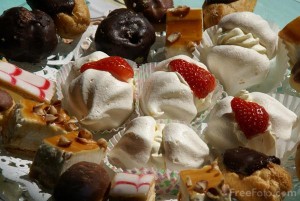 One of the things that masquerades as hunger is a wonky blood sugar. If you eat something sweet, especially something with a high glycemic index, your blood sugar rises quickly. Your pancreas looks up and says, “Wow, dump a bunch of insulin. We have sugar to process.” If everything is running at peak efficiency, your pancreas guesses right and drops the perfect amount of insulin to process the sugar. Your cells pick up the insulin and use it to process the sugar, and everyone lives happily ever after. If, however, you’ve eaten a typical Western diet with lots of sugar over the course your life, your cells are a bit shell-shocked. The pancreas releases insulin and the cells just sit there. So the pancreas releases more. Before you know it, you have too much insulin in your bloodstream. This insulin finishes processing the sugar you ate and then settles in to work on the sugar you normally keep in your blood to run things like your brain. You now have low blood sugar. You haven’t burned the calories in the original sugar hit yet, but your blood stream thinks it’s out of fuel.
One of the things that masquerades as hunger is a wonky blood sugar. If you eat something sweet, especially something with a high glycemic index, your blood sugar rises quickly. Your pancreas looks up and says, “Wow, dump a bunch of insulin. We have sugar to process.” If everything is running at peak efficiency, your pancreas guesses right and drops the perfect amount of insulin to process the sugar. Your cells pick up the insulin and use it to process the sugar, and everyone lives happily ever after. If, however, you’ve eaten a typical Western diet with lots of sugar over the course your life, your cells are a bit shell-shocked. The pancreas releases insulin and the cells just sit there. So the pancreas releases more. Before you know it, you have too much insulin in your bloodstream. This insulin finishes processing the sugar you ate and then settles in to work on the sugar you normally keep in your blood to run things like your brain. You now have low blood sugar. You haven’t burned the calories in the original sugar hit yet, but your blood stream thinks it’s out of fuel.
What does that have to do with hunger? Low blood sugar feels a lot like hunger. If your blood sugar is low, you’ll want food. If your blood sugar drops before you finish burning the calories in the last meal (or snack) you ate, your body will tuck the excess calories away for later (in other words, will turn them to fat) and will ask for more food.
How do you keep your blood sugar stable? The biggest thing is to eat low on the glycemic index. Lay off the processed sugar, go easy on all processed carbs. Limit the sugar you take in even if it is “good sugar” like fruit juice. Eat carbs with a little bit (Hey, I said a little bit!) of good quality minimally processed oil and a little bit of protein. If you’re like most people, the sugar cravings will be fierce for about a week. If you stay off processed sugar and carbs completely, they should die back within a week or two. If the sugar jonesing is driving you crazy, find a good traditional Chinese medicine practitioner (the real thing, not just a chiropractor with needles or a community acupuncture needle jockey). They will be able to help a lot.
Blood sugar is only one thing that can masquerade as hunger. Another is simply habit. You get home from work or school, and what to you do? You sit down with your TV in the evening, and what do you do? Can you do income taxes without M&Ms or Budweiser? Is there a soda or a bag of chips sitting next you at the computer as you read this? Habits and rituals feel a lot like hunger sometimes.
 Want a challenge? Pick your worst food habit–eating in the car, in front of the TV, at the computer, whatever–and see if you can go a week without doing it. Think of it as liberation. If someone knocked on your door every evening at 8:30 and forced you to eat, you’d probably be pretty ticked off. The habit is doing the same thing. By breaking it, you are breaking some of your self-built chains. Perhaps more importantly, you are training yourself to recognize when you are hungry and when you just usually eat food.
Want a challenge? Pick your worst food habit–eating in the car, in front of the TV, at the computer, whatever–and see if you can go a week without doing it. Think of it as liberation. If someone knocked on your door every evening at 8:30 and forced you to eat, you’d probably be pretty ticked off. The habit is doing the same thing. By breaking it, you are breaking some of your self-built chains. Perhaps more importantly, you are training yourself to recognize when you are hungry and when you just usually eat food.
Boredom also feels like hunger. So does sadness, ennui, existential angst. It makes sense. Eat the right food (or the wrong food, depending on how you look at it), and you have an instant party in you brain. Entertainment food keeps your brain distracted. You don’t have to look at your life or address what’s bumming you out when you are under the influence of cheesecake, or onion rings, or pizza. Do you know the two-year-old in your brain, the one who, every time you try to meditate, pray, study, or get some work done, pokes its head up and says, “I’m bored. This is stupid. I want to do something fun.” That two-year-old can feel just like hunger. And by the way, so can the six-month-old in your brain who just wants to put everything in his mouth for the sake of putting everything in his mouth.
And finally, what goes on in your brain during Red Lobster and Cadbury commercials also masquerades as hunger. Go ahead and tell me you aren’t affected by commercials. We’ll go find an fMRI and run you through and take a look at everything that lights up when you watch a commercial. If you’re watching a commercial for a major national food company, you can bet they’ve run folks through tests and scans to make sure the commercial works. Do you think Coke would pay “American Idol” who-know-how-many-millions to place Coke glasses and commercials strategically through the show if they weren’t sure they were working? You can bet they’ve tested those placements, and that they’re working on you on some level. Next time you get a craving 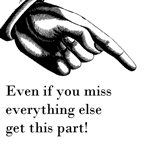 while watching TV, ask yourself, “Why am I hungry for that? Why now?” Watch carefully, and you might be able to see the manipulation at work.
while watching TV, ask yourself, “Why am I hungry for that? Why now?” Watch carefully, and you might be able to see the manipulation at work.
How do you tell if it’s real hunger? Where does the feeling originate? Is it above your neck? It’s not hunger. Is it below your neck–in your stomach, or in a shakiness in your muscles? That’s probably hunger. (Though if you ate that Three Musketeers bar in your desk about forty-five minutes ago, you could very well have a blood sugar thing going on. Remember this feeling next time you’re succumbing to the marketing onslaught in the grocery store checkout line. If you buy that Klondike Bar, its your own stupid fault if you can’t tell if it’s hunger an hour after you eat it. . . . But I digress.) Pseudo-hunger is usually a mouth thing, a brain thing. It has triggers, but it doesn’t have an organic cause.
Hunger is a gift. Pseudo-hunger is a master cracking its whip, making you dance. Hunger keeps you healthy. Pseudo-hunger can make you fat and sick. Learning to tell the difference is a step toward healthy eating.
I’m writing these posts–hopefully this will end up being a series–to talk about what I’ve learned about food, weight, health, and what all that has to do with mind and body. It’s a huge topic, but if comes down to something quite simple: Food can make you healthy, or food can make you sick. Food can make you fit, or food can make you fat and sluggish. Given the messy priorities of modern agribusiness, restaurants and food manufacturers who care more about your return business than your health, and the fact that it takes work and skill to eat well, it’s little wonder that we all tend to slide toward poor food and poor health. The first step toward digging yourself out of this pseudo-food quagmire we’re all in is information.
So. . . Important chunk of information number one: If you look at the way that food affects your brain, you’ll see that there are two different kinds of food.
 The first kind of food is real food. Real food is grains, vegetables, meats. If these real foods come with a label–they often don’t–the label simply says “chicken” or “tomatoes” or “rice.” If you look at the ingredients list, it will have one entry and one entry only. When you cook them, you cook them like real people have always cooked real food: you bake them, braise them, stir fry them, boil them, steam them. If you’ve ever done any deep frying, you know why you don’t deep fry them, at least not very often. Deep frying is expensive (because of all that oil that gets used only once or twice), and it’s a pain. It splashes, splatters, drips. It’s tough to clean up after. And then there’s the whole problem of disposing of the oil. Trust me: if you cook from scratch for most meals, you won’t want to mess with deep frying very often.
The first kind of food is real food. Real food is grains, vegetables, meats. If these real foods come with a label–they often don’t–the label simply says “chicken” or “tomatoes” or “rice.” If you look at the ingredients list, it will have one entry and one entry only. When you cook them, you cook them like real people have always cooked real food: you bake them, braise them, stir fry them, boil them, steam them. If you’ve ever done any deep frying, you know why you don’t deep fry them, at least not very often. Deep frying is expensive (because of all that oil that gets used only once or twice), and it’s a pain. It splashes, splatters, drips. It’s tough to clean up after. And then there’s the whole problem of disposing of the oil. Trust me: if you cook from scratch for most meals, you won’t want to mess with deep frying very often.
Your brain on real food looks like this: You’re hungry. You eat the real food. Your brain registers that the food is satisfying. When you are full, your brain says, “I’m full.” In other words, your brain reacts to real food like it reacts to, well, food.
The second kind of food is entertainment food. It’s food with a substantial amount of of at least one, but sometimes all three of the following: sugar, salt, and fat. Think of birthday cake. Sugar and fat. Think of potato chips. Salt and fat. Think of onion blossoms with dipping sauce. Sugar, fat and salt. Most fast food is entertainment food. So are a lot of the prepared foods you find in the freezer section of your grocery story. Read the labels. You’ll be amazed at the amount of sugar, fat, and salt a manufacturer can pack into a small amount of prepared food.
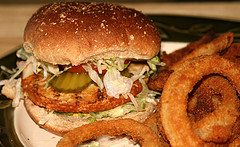 So why do I call it entertainment food? Because of how your brain reacts to it. Watch your brain on entertainment food. You eat it. Your brain’s pleasure center lights up. “Good stuff,” it says. “I want more.” So you feed it more. How does it respond? “Good stuff,” it says. “I want more.” The pleasure center of your brain shouts down the part of the brain that says when it’s had enough.
So why do I call it entertainment food? Because of how your brain reacts to it. Watch your brain on entertainment food. You eat it. Your brain’s pleasure center lights up. “Good stuff,” it says. “I want more.” So you feed it more. How does it respond? “Good stuff,” it says. “I want more.” The pleasure center of your brain shouts down the part of the brain that says when it’s had enough.
Think of the last time you had, say, fish and chips or pizza. It’s very easy to eat 1000 or even 2000 calories of of these foods. Now think about eating 1000-2000 calories of, for example, a nice hearty bowl of lentil soup. You probably couldn’t do it. Your body and brain wouldn’t let you. Why? Because a different part of your brain is in charge when you eat real food than is in charge when you eat entertainment food. Food is supervised by the food center. Entertainment food is supervised by the pleasure center, the center in charge of drugs, alcohol, and sex. And that part of you brain doesn’t know when to quit.
Now, let’s say you are a food manufacturer or a restaurant owner. You can offer food that is good, nutritious fare, that customers eat in moderation and appreciate. Or you can offer food that lights up a customer’s brain like Vegas at night, that make them always want more, that calls to them a week later. Which one is going to make you more money? Is it any wonder that most of the food available to us already prepared is entertainment food?
Take a look at David A. Kessler’s The End of Overeating. It’s an eye opener. Overeating is only marginally about willpower. It’s mostly about your brain getting used to one long party. As with any party, however, if we live in the party constantly, day in and day out without a break it makes us sick and addicted. It’s true of any of the behaviors that light us up. It’s true of what we eat.
Photos by mikehipp and Emily Carlin. Thanks, guys, for the Creative Commons licensing!
 Undress Me in the Temple of Heaven: A Memoir by Susan Jane Gilman
Undress Me in the Temple of Heaven: A Memoir by Susan Jane Gilman
My rating: 4 of 5 stars
I was surprised how much I liked this book. The cover and title suggest something that’s not really up my alley, but this really is a case where you can’t judge a book by its cover. The protagonist (the author, as this is autobiographical) is a young woman just our of an ivy league college. She and a casual friend decide to backpack around the world before settling down. Their first stop is China shortly after it was opened to Westerners. Before long the author’s companion begins acting strangely, disappearing to do secret work and claiming to be followed by enemy agents.
Having spent some time in Bolivia and Japan when I was the age the author was in the story, I can attest to the fact that a complete change in language, food, sanitary facilities, and company can do strange things to a person’s head. Once you’ve operated that far outside your comfort zone, you will never see your comfort zone quite the same way ever again. The author captures this very unique kind of stress brilliantly. The book is funny, captivating, and quietly insightful.
View all my reviews
This is the global consciousness dot rendered in real time. The global consciousness hypothesis says that “periods of collective attention or emotion in widely distributed populations will correlate with deviations from expectation in a global network of physical random number generators.” According to the code, red or blue says that there is something that is occupying the attention of a unusually high percentage of the population at the moment (the same thing focusing the attention of a wide array of people). Green and yellow are normal focus. Things that occupy the world’s attention–extremely large natural or human-made disasters–are often accompanied by random number generator producing patterns of numbers that are statistically highly unlikely.
Interesting. How do we interpret this strange phenomenon? Beats me.
 The Thorn Birds by Colleen McCullough
The Thorn Birds by Colleen McCullough
My rating: 4 of 5 stars
The beginning of this book was like traveling to Australia and living on a sheep ranch. The descriptions were vivid, and the people lived and breathed. The first generations in this grand saga–Fee and Paddie, Meggie and Father Ralph–were multidimensional and interesting. But the final generation–Justine and Dane–felt flat for me. Dane was too good to be true, and Justine was someone not even her mother could know (much less the reader). Still, I will probably read The Thorn Birds again sometime. It’s the kind of historical that allows you to live in another world for a while, and they are the best kind.
View all my reviews
Buy the Thorn Birds on Amazon.com
 The Book of Tea by Alain Stella
The Book of Tea by Alain Stella
My rating: 4 of 5 stars
One species, several different varieties, and hundreds of ways of processing the leaves give us world of tea we now have. I never realized that green, black, white, oolong, and puer tea all come from the same plant. The only difference is in the processing. This book is a great introduction to the world of tea–where and how it is grown, how it is processed, and how it has made its way into various cultures. I have been trying different teas from Seven Cups in Tucson. Now thanks to Stella’s book, I have a little better idea what I’m drinking.
View all my reviews
